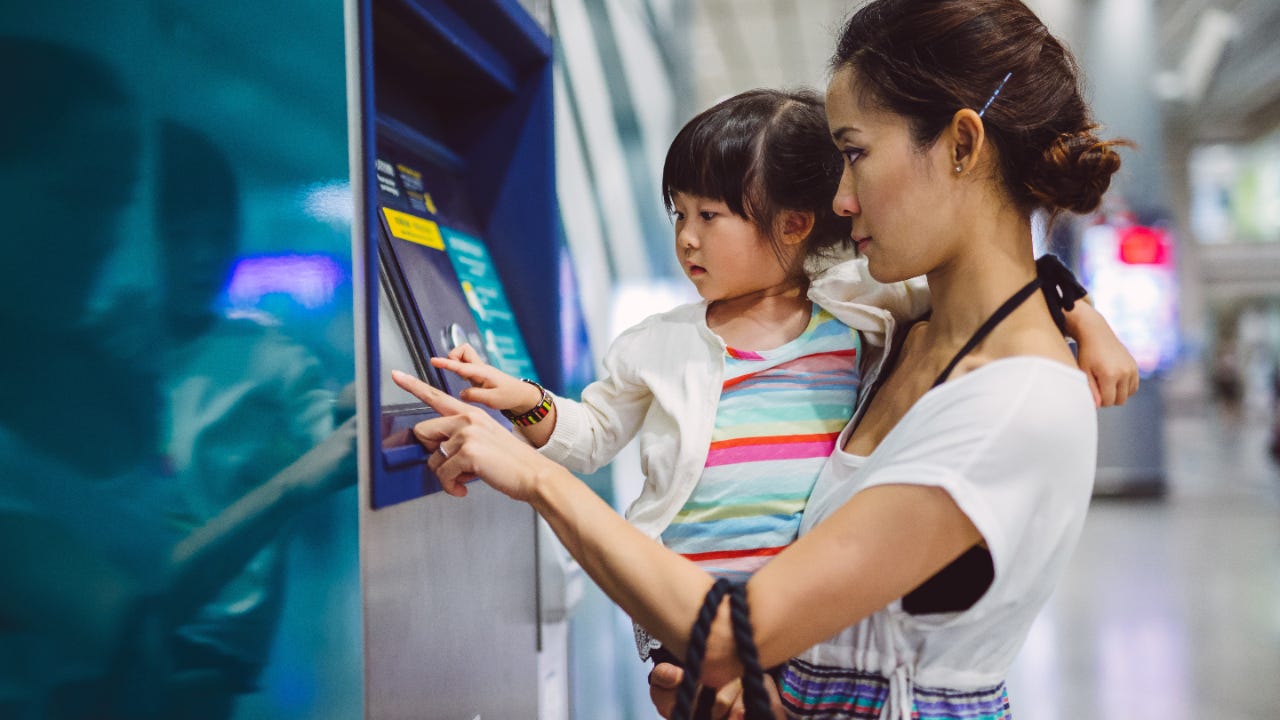What are Bitcoin ATMs and how do they work?

Our writers and editors used an in-house natural language generation platform to assist with portions of this article, allowing them to focus on adding information that is uniquely helpful. The article was reviewed, fact-checked and edited by our editorial staff prior to publication.
The value of bitcoin recently reached an all-time high, surpassing the cryptocurrency’s previous peak in November 2021. With the rally, many investors are taking their first dip into the crypto market. If you’re one of them, you may have noticed Bitcoin ATMs but wonder what they are.
Like standard ATMs, Bitcoin ATMs are a type of electronic kiosk where customers can make financial transactions, but they’re designed for cryptocurrency rather than cash. There are approximately 31,000 Bitcoin ATMs and tellers across the United States, according to CoinATMRadar.com. Here’s what you should know about them if you’ve ever considered using one.
What are Bitcoin ATMs?
Bitcoin ATMs, sometimes referred to as BTMs, are kiosks where customers can buy and sometimes also sell Bitcoin, a type of cryptocurrency. Bitcoin ATMs are owned and operated by third-party companies — the two largest networks are Coinhub and Coinme.
To use a Bitcoin ATM, customers can simply insert cash or a debit card to exchange their traditional currency for Bitcoin currency. While Bitcoin ATMs are generally accessible to everyone, they may require that the customer have an existing account with the Bitcoin ATM operator.
Cryptocurrency (including Bitcoin) isn’t connected to a bank account and is entirely virtual, utilizing blockchain technology. That means that when currency is exchanged at a Bitcoin ATM, it does not appear in a bank account or as cash, but rather it is transferred into a separate, digital Bitcoin wallet.
Bitcoin ATMs can be located using the Bitcoin website.
Benefits and risks of Bitcoin ATMs
Benefits:
- Ease of access: Because cryptocurrency isn’t tied to a central system, anyone can buy or trade it, regardless of whether they have a bank account. The widespread availability of Bitcoin ATMs make it easy to buy (or sell) Bitcoin by trading in cash.
- Privacy: Bitcoin ATMs often don’t involve sharing your personal information, though in some cases they require you to scan an ID before completing a transaction.
- Ability to sell Bitcoin: Some Bitcoin ATMs come with bi-directional functionality, so customers can also use them to sell Bitcoin.
Risks:
- Lack of cryptocurrency options: Typically, Bitcoin ATMs only allow you to trade cash in for Bitcoin. If you’re looking to buy other types of cryptocurrency, you’ll likely need to go to an online crypto exchange.
- Frequent target for scams: One of the downsides to the anonymity and accessibility of Bitcoin ATMs is that they can easily be taken advantage of by scammers and fraudsters. In 2021, the FBI noted an increase in scammers that directed victims to retrieve or send money through Bitcoin ATMs under false pretenses. If someone falls for a scam using a Bitcoin ATM, it’s especially difficult to track down the scammer and recover funds.
- Lack of protection: Bitcoin and other cryptocurrencies aren’t regulated by the federal government. That means that when you get Bitcoin from a Bitcoin ATM and add it to your digital wallet, it’s not insured by the Federal Deposit Insurance Corp. (FDIC), as it would be in a bank account, to protect against theft or loss of funds.
Bitcoin ATM fees
Bitcoin ATMs have gotten some flak recently for charging high transaction fees. Truthout, a nonprofit organization, reports that Bitcoin Depot ATMs may charge up to 20 percent in exchange fees and don’t disclose the total cost to customers.
By contrast, it’s easy to find online cryptocurrency exchanges with transaction fees of less than 1 percent.
In addition to transaction fees, some Bitcoin ATM operators may charge a variable miner fee. This fee is used to pay Bitcoin miners, who add Bitcoin transactions to the blockchain to validate them.
Before using a Bitcoin ATM, make sure to research potential fees charged and look for the lowest fees.
How to use a Bitcoin ATM
What’s common to all Bitcoin ATMs is that you can use them to purchase Bitcoin by exchanging traditional currency for it. You’ll need a cryptocurrency wallet, which is where the Bitcoin is stored, since the digital currency isn’t tied to a bank account. Once the amount of cash you want to exchange for Bitcoin is inserted into the ATM, you can enter your wallet’s address or QR code into the machine. The cash will be exchanged for Bitcoin at the current market rate and sent to your digital wallet.
Some Bitcoin ATMs are bidirectional, meaning you can both purchase and sell Bitcoin at them. In the latter case, you can enter the amount of Bitcoin you’d like to exchange for cash, and collect the cash or have it deposited onto your debit card.
Bitcoin ATMs can also be used to send Bitcoin to another person. Instead of entering your crypto wallet address, you enter the wallet address of the person you’d like to send the Bitcoin to, and then the Bitcoin you purchase will be deposited into their wallet.
In some cases, and depending on the purchase amount, you may need to provide a form of ID by scanning or taking a picture of it at the machine before completing the currency exchange.
Bottom line
If you’re interested in trading in cash to buy Bitcoin — or in selling Bitcoin you already have — Bitcoin ATMs could be a convenient way to do so. They can be found across the U.S., What’s more, you don’t need to share any bank account information to use them. All that’s required is a cryptocurrency wallet.
Look out for the fees these ATMs charge, though, which can be high. It’s also important to be wary of scammers, who often take advantage of the decentralized nature of Bitcoin ATMs. Finally, make sure you only send money to those you know and trust.
– Bankrate’s Marcos Cabello updated this article.





